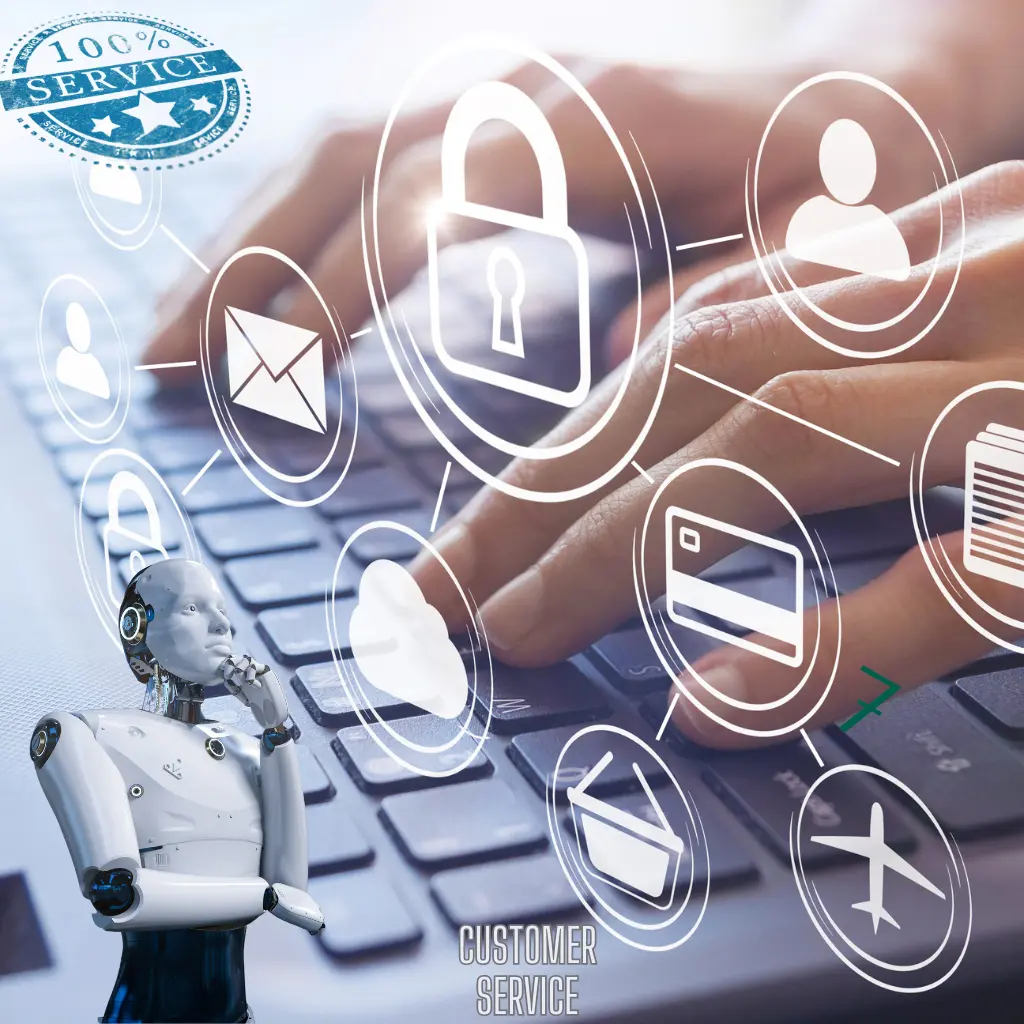
Guardians of Trust
Unveiling the Power of Customer Service Tools for Data Security and Privacy
In the ever-evolving landscape of customer service, the paramount importance of data security and privacy is accentuated by the advent of cutting-edge technologies.
As businesses strive to automate processes and harness the power of AI, the emergence of Customer Service Tools for Data Security and Privacy Tools has become a cornerstone in the pursuit of operational excellence.
This discussion explores the intricacies of building AI-driven solutions, including fraud detection, anomaly identification, and encryption mechanisms tailored to fortify data security and uphold privacy standards. From business acumen to technical expertise, we navigate the multifaceted landscape of creating tools that streamline customer service processes and ensure the sanctity of customer data in an era where privacy is paramount.
Table of Contents

Arindam Roy
An Automation Consultant with 25+ years of IT Experience
5 Social Data Security and Privacy Tool ideas for the Customer Service
Customer Service Tools for Data Security and Privacy Tools:
1. AI-based Fraud Detection System:
This tool is a cornerstone of our commitment to data security. It employs sophisticated machine learning algorithms to analyze customer interactions and identify patterns indicative of fraudulent activities. By continuously learning from evolving fraud patterns, this tool enhances our ability to detect and prevent potential security threats within customer service proactively.
2. Privacy Compliance Monitoring Tool:
Our Privacy Compliance Monitoring Tool is essential to ensure adherence to data privacy regulations. This tool systematically monitors and analyzes customer interactions by leveraging advanced AI technologies, ensuring our processes align with the latest privacy standards. This proactive approach safeguards customer data and reinforces our position as a market leader in implementing and upholding privacy compliance within customer service.
3. Anomaly Detection for Unusual Customer Behavior:
The Anomaly Detection tool utilizes machine learning capabilities to detect unusual customer behaviour patterns and identify potential security threats. Constantly analyzing vast datasets enables us to promptly recognize deviations from normal behaviour, allowing for swift intervention and protection against security breaches. This tool ensures customer interactions’ integrity and bolsters our data security commitment.
4. Customer Data Encryption and Protection:
The Customer Data Encryption and Protection tool represents our dedication to the highest data security standards. Powered by AI-driven encryption mechanisms, this tool ensures that customer data remains secure and confidential. Implementing state-of-the-art encryption technologies is a robust shield against unauthorized access, assuring customers that their sensitive information is handled with the utmost care and protection throughout their interactions with our customer service platform.
5. AI-driven Security Incident Response System:
As a proactive measure against emerging threats, our AI-driven Security Incident Response System takes data security to the next level. Leveraging AI, this tool continuously monitors potential security incidents in real-time. Swiftly detecting and responding to security threats fortifies our overall cybersecurity posture. This system exemplifies our dedication to staying ahead of evolving challenges and maintaining the trust of our customers through prompt and effective security incident response mechanisms.
In conclusion, our suite of Customer Service Tools for Data Security and Privacy Tools underscores our commitment to safeguarding customer information and positions us as a market leader in adopting cutting-edge AI technologies to ensure high data privacy compliance standards.
AI-based fraud detection system
Business Knowledge Required to Build:
- In-depth understanding of fraud patterns specific to the customer service domain.
- Compliance knowledge related to data security and privacy regulations.
- Familiarity with customer service workflows and potential vulnerabilities in customer interactions.
Software Knowledge Needed to Build:
- Proficiency in machine learning algorithms for fraud detection.
- Knowledge of development languages such as Python, R or similar for algorithm implementation.
- Expertise in data preprocessing, feature engineering, and model training.
- Understanding of database management systems for handling large datasets.
Hardware Needed to Run:
- High-performance computing resources, potentially utilizing GPUs for efficient model training.
- Secure storage infrastructure to handle sensitive customer data.
- Scalable architecture to accommodate growing data volumes and processing demands.
Training Required to Run Once Created:
- Training for data scientists and analysts on interpreting the output of the AI-based fraud detection system.
- Ongoing training to stay updated on emerging fraud patterns and evolving machine learning techniques.
- Training for customer service teams on using the insights generated by the tool to enhance security measures.
Various Integrations Necessary for Execution:
- Integration with customer service platforms and CRM systems to access relevant customer data.
- Collaboration with communication channels to enhance real-time detection capabilities.
- Integration with incident response systems for prompt action upon detecting potential fraud.
Comparative Tools Already Available in the Market:
- Established tools include IBM Trusteer, Featurespace, and FICO Falcon for fraud detection in various domains.
- Generic security tools like Splunk and SIEM solutions may offer fraud detection capabilities.
- Customizable fraud detection modules within comprehensive cybersecurity platforms.
Recommendation:
Given AI-based fraud detection’s complexity and critical nature, a hybrid approach of buying an existing solution and customizing it to align with specific customer service workflows is recommended.
Cost/Benefits Analysis on the Recommendation:
- Costs:
- Licensing fees for third-party fraud detection platforms.
- Customization and integration costs.
- Ongoing maintenance and support expenses.
- Benefits:
- Faster implementation compared to building from scratch.
- Access to advanced features and continuous updates from established platforms.
- Reduced development and testing efforts, ensuring quicker deployment.
In conclusion, the recommended approach for developing AI-based Fraud Detection Systems within the context of Customer Service Tools for Data Security and Privacy Tools is to buy and customize existing solutions. This ensures efficiency, access to advanced features, and quicker deployment, providing a competitive advantage in detecting fraudulent activities within customer interactions.
Privacy compliance monitoring tool
Business Knowledge Required to Build:
- Comprehensive understanding of data privacy regulations applicable to the industry and regions in which the company operates.
- Knowledge of the specific data types collected, processed and stored in customer service interactions.
- Familiarity with internal policies and procedures related to data privacy and compliance.
Software Knowledge Needed to Build:
- Proficiency in AI technologies, particularly natural language processing (NLP) and machine learning (ML) algorithms, to interpret and analyze textual and contextual data for privacy compliance.
- Development skills in languages like Python and Java to develop monitoring tools.
- Knowledge of regulatory frameworks and compliance standards to design algorithms that align with legal requirements.
Hardware Needed to Run:
- Moderate computing resources may suffice, as the monitoring tool primarily involves data analysis and algorithm execution.
- Adequate storage infrastructure to handle logs and records for compliance monitoring.
- Cloud-based solutions can be considered for scalability and flexibility.
Training Required to Run Once Created:
- Training for legal and compliance teams to understand the outputs and insights generated by the privacy compliance monitoring tool.
- Training for data analysts or compliance officers on utilizing the tool’s interface for monitoring and reporting.
- Continuous education to stay informed about evolving privacy regulations.
Various Integrations Necessary for Execution:
- Integration with customer databases and CRM systems to access relevant customer information.
- Connectivity with data sources across different customer service channels, including chat logs, emails, and phone interactions.
- Collaboration with legal and compliance management systems for streamlined reporting and documentation.
Comparative Tools Already Available in the Market:
- Existing tools such as OneTrust and TrustArc offer comprehensive privacy compliance management but may not specialize in customer service interactions.
- Generic compliance tools like IBM Guardium and Varonis may have features that apply to privacy monitoring.
- Customizable modules within integrated GRC (Governance, Risk, and Compliance) platforms.
Recommendation:
Depending on the complexity of regulatory requirements, the recommendation could lean towards buying an existing solution and customizing it to fit the needs of the customer service domain.
Cost/Benefits Analysis on the Recommendation:
- Costs:
- Licensing fees for third-party privacy compliance tools.
- Customization and integration costs.
- Ongoing maintenance and support expenses.
- Benefits:
- Faster implementation compared to building from scratch.
- Access to established compliance frameworks and updates.
- Reduced development efforts and quicker deployment.
In conclusion, the recommended approach to developing a Privacy Compliance Monitoring Tool within the context of Customer Service Tools for Data Security and Privacy Tools is to buy and customize existing solutions. This ensures efficiency, compliance with evolving regulations, and quicker deployment, providing a competitive advantage in ensuring data privacy within customer service interactions.
Anomaly detection for unusual customer behaviour
Business Knowledge Required to Build:
- In-depth knowledge of standard customer behaviour patterns within the industry and company context.
- Understanding potential security threats and unusual activities that may manifest in customer interactions.
- Familiarity with regulatory requirements related to data security and privacy.
Software Knowledge Needed to Build:
- Proficiency in machine learning algorithms, especially those related to anomaly detection.
- Development skills in languages like Python and R for tool development.
- Expertise in data preprocessing, feature engineering, and model training to effectively identify anomalies in customer behaviour.
Hardware Needed to Run:
- Moderate to high-performance computing resources, depending on the complexity of the machine learning models.
- Adequate storage infrastructure to handle historical customer interaction data for training and ongoing analysis.
- Cloud-based solutions for scalability and flexibility.
Training Required to Run Once Created:
- Training for data scientists and analysts on interpreting the output of the anomaly detection tool.
- Familiarization with the machine learning models and parameters used in the tool.
- Continuous education to adapt to evolving customer behaviour and potential new security threats.
Various Integrations Necessary for Execution:
- Integration with customer databases and CRM systems to access historical customer behaviour data.
- Collaboration with communication channels, such as chat logs, emails, and phone interactions.
- Connectivity with incident response systems for immediate action upon detecting anomalies.
Comparative Tools Already Available in the Market:
- SIEM solutions such as Splunk and IBM QRadar may contain anomaly detection features.
- Tools like Darktrace and Varonis focus on anomaly detection for cybersecurity.
- Customizable modules within comprehensive cybersecurity platforms.
Recommendation:
A buy-and-customize approach may be beneficial depending on the expertise available and the company’s specific needs. Purchasing an existing anomaly detection solution and tailoring it to align with the unique customer service environment could provide efficiency.
Cost/Benefits Analysis on the Recommendation:
- Costs:
- Licensing fees for third-party anomaly detection platforms.
- Customization and integration costs.
- Ongoing maintenance and support expenses.
- Benefits:
- Faster implementation compared to building from scratch.
- Access to advanced anomaly detection features and continuous updates from established platforms.
- Reduced development and testing efforts.
In conclusion, the recommended approach is to buy and customize existing solutions to develop Anomaly Detection for Unusual Customer Behavior within the context of Customer Service Tools for Data Security and Privacy Tools. This ensures efficiency, access to advanced features, and quicker deployment, providing a competitive advantage in identifying security threats and unusual activities within customer interactions.
Customer data encryption and protection
Business Knowledge Required to Build:
- Comprehensive understanding of customer data collected, processed and stored by the company.
- Knowledge of industry-specific data security regulations and compliance requirements.
- Awareness of potential vulnerabilities in customer service processes that could pose security risks.
Software Knowledge Needed to Build:
- Proficiency in AI-driven encryption mechanisms and protocols.
- Programming skills in Python and Java for developing encryption algorithms and integrating existing systems.
- Knowledge of secure coding practices to ensure the robustness of the encryption and protection mechanisms.
Hardware Needed to Run:
- Moderate computing resources for encryption and decryption processes.
- Adequate storage infrastructure to accommodate encrypted customer data.
- Secure hardware modules, such as hardware security modules (HSMs), are used for enhanced encryption and essential protection.
Training Required to Run Once Created:
- Training for IT and security teams on implementing and managing AI-driven encryption and protection mechanisms.
- Familiarization with the encryption key management system and the overall security infrastructure.
- Continuous education to stay updated on emerging encryption technologies and potential threats.
Various Integrations Necessary for Execution:
- Integration with customer databases and CRM systems to seamlessly implement encryption mechanisms.
- Collaboration with identity and access management systems ensures secure encrypted data access.
- Integration with incident response systems for real-time detection and response to security incidents.
Comparative Tools Already Available in the Market:
- Established encryption tools like Symantec, McAfee, and Microsoft BitLocker focus on data security but something other than AI-driven.
- Cloud services like AWS and Azure offer encryption services, but customization may be limited.
- Comprehensive cybersecurity platforms like Palo Alto Networks and Cisco Umbrella may include encryption features.
Recommendation:
Considering the critical nature of customer data security, a buy-and-customize approach is recommended. Purchasing an existing encryption solution and customizing it to align with the unique customer service environment can provide efficiency while meeting specific business requirements.
Cost/Benefits Analysis on the Recommendation:
- Costs:
- Licensing fees for third-party encryption platforms.
- Customization and integration costs.
- Ongoing maintenance and support expenses.
- Benefits:
- Faster implementation compared to building from scratch.
- Access to established encryption protocols and continuous updates from reputable platforms.
- Reduced development and testing efforts.
In conclusion, buying and customizing existing solutions is recommended to develop Customer Data Encryption and Protection within Customer Service Tools for Data Security and Privacy Tools. This ensures efficiency, access to advanced features, and quicker deployment, providing a competitive advantage in safeguarding customer data.
AI-driven security incident response system
Business Knowledge Required to Build:
- A deep understanding of the company’s IT infrastructure, network architecture, and data flows is required to identify potential security vulnerabilities.
- Knowledge of industry-specific cybersecurity threats and compliance requirements.
- Familiarity with customer service workflows and potential security issues in customer interactions.
Software Knowledge Needed to Build:
- Expertise in AI and machine learning algorithms for real-time threat detection and analysis.
- Programming skills in Python, Java, or similar languages are needed to develop the incident response system.
- Knowledge of cybersecurity protocols, encryption, and secure coding practices.
Hardware Needed to Run:
- High-performance computing resources, especially for processing large datasets in real time.
- Adequate storage infrastructure for storing logs, incident data, and AI model parameters.
- Scalable architecture to handle varying loads during security incidents.
Training Required to Run Once Created:
- Training for security operations and incident response teams on utilizing the AI-driven system for threat detection and response.
- Familiarity with AI algorithms and the interpretation of security incident alerts.
- Continuous training to adapt to emerging cybersecurity threats and updates to the AI models.
Various Integrations Necessary for Execution:
- Integration with cybersecurity tools and threat intelligence feeds for real-time threat data.
- Connectivity with network monitoring systems to identify abnormal patterns.
- Collaboration with customer service platforms and CRM systems to correlate security incidents with customer interactions.
Comparative Tools Already Available in the Market:
- Leading cybersecurity platforms offer advanced incident response capabilities, such as CrowdStrike, Palo Alto Networks Cortex XSOAR, and IBM Resilient.
- SIEM solutions like Splunk and ArcSight provide incident detection but may require additional customization for AI-driven responses.
- Customizable modules within comprehensive cybersecurity platforms.
Recommendation:
Given the complexity of cybersecurity threats and the availability of advanced tools, the recommendation is to buy and customize an existing solution. This allows leveraging established features while tailoring the system to align with the specific requirements of the customer service domain.
Cost/Benefits Analysis on the Recommendation:
- Costs:
- Licensing fees for third-party incident response platforms.
- Customization and integration costs.
- Ongoing maintenance and support expenses.
- Benefits:
- Faster implementation compared to building from scratch.
- Access to advanced incident response features and continuous updates from reputable platforms.
- Reduced development and testing efforts.
In conclusion, the recommended approach for developing an AI-driven security Incident Response System within the context of Customer Service Tools for Data Security and Privacy Tools is to buy and customize existing solutions. This ensures efficiency, access to advanced features, and quicker deployment, providing a competitive advantage in enhancing overall cybersecurity for customer interactions.
Conclusion
In the dynamic customer service landscape, the imperative integration of advanced technologies is evident through developing robust solutions such as Customer Service Tools for Data Security and Privacy. As companies, especially those with a longstanding presence in the domain, embark on the journey of automation and AI integration, these tools stand out as pivotal guardians of customer data integrity. The business knowledge required spans a spectrum, demanding a profound understanding of industry regulations, customer behaviour, and potential security threats within customer interactions.
The software knowledge required encompasses proficiency in cutting-edge AI algorithms, encryption mechanisms, and incident response protocols. Effective real-time threat detection requires hardware infrastructure to handle computational demands while ensuring scalable and secure storage. The training component is crucial for the technical teams operating these tools and for all stakeholders to foster a culture of data security and privacy awareness.
Integration with existing systems and collaborative efforts with cybersecurity tools define the execution phase, where these tools become seamlessly woven into the fabric of customer service operations. While comparative tools already exist in the market, the strategic recommendation is often to leverage and customize existing solutions, balancing efficiency with specificity.
In the cost/benefits analysis, the advantages of accelerated deployment, access to advanced features, and continuous updates weigh heavily against the investment costs. In conclusion, as companies embrace Customer Service Tools for Data Security and Privacy Tools, they fortify their commitment to safeguarding customer trust, positioning themselves as industry leaders in the era of advanced customer service technologies.
Related Articles
- 50 AI Tools for the Customer Services Domain
- 5 Facial Recognition and Emotion Analysis Tools of Customer Service
- 5 Customer Service Speech Recognition and Processing Tools
- 5 Customer Service Predictive Analytics and Recommendation
- 5 Customer Service Tolls for Automation and RPA
- 5 Customer Service Natural Language Processing (NLP) Tools
- 5 Customer Service Tools for Knowledge Management
- 5 Customer Service Tools for Continuous Learning and Improvement
- 5 Customer Service Tools for Customer Survey Analysis
- 5 Customer Service Tools for Social Media Monitoring




















